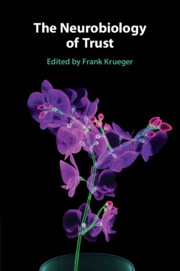Book contents
- The Neurobiology of Trust
- The Neurobiology of Trust
- Copyright page
- Dedication
- Contents
- Figures
- Tables
- Contributors
- Abbreviations
- Introduction
- Part I Fundamental Level of Trust
- Part II Neuropsychological Level of Trust
- Part III Neurocharacteristic Level of Trust
- Part IV Neuromolecular Level of Trust
- Part V Neuropathological Level of Trust
- Chapter 16 Trust and Psychotic Disorders
- Chapter 17 Trust and Personality Disorders
- Chapter 18 Trust and Lesion Evidence
- Index
- References
Chapter 17 - Trust and Personality Disorders
Phenomenology, Determinants, and Therapeutical Approaches
from Part V - Neuropathological Level of Trust
Published online by Cambridge University Press: 09 December 2021
- The Neurobiology of Trust
- The Neurobiology of Trust
- Copyright page
- Dedication
- Contents
- Figures
- Tables
- Contributors
- Abbreviations
- Introduction
- Part I Fundamental Level of Trust
- Part II Neuropsychological Level of Trust
- Part III Neurocharacteristic Level of Trust
- Part IV Neuromolecular Level of Trust
- Part V Neuropathological Level of Trust
- Chapter 16 Trust and Psychotic Disorders
- Chapter 17 Trust and Personality Disorders
- Chapter 18 Trust and Lesion Evidence
- Index
- References
Summary
Psychopathological descriptions, diagnostic criteria, and experimental studies suggest issues with trust across the range of different personality disorders. While the majority of findings refers to Borderline Personality Disorder, the studies investigating trust issues in other personality disorders suggest differential patterns of trust impairments, but also common determinants. For example, traumatization during childhood and adolescence seems to be important for alterations in trust across the spectrum of personality disorders. In this chapter, we describe the definition and classification of different personality disorders, report findings elucidating the specific importance of issues with trust in this group of mental disorders and present therapeutic approaches aiming to restore trust. Most of the empirical studies focus on self-reports and behavioral indices of trust. In contrast neurobiological studies investigating the neuronal correlates of trust impairments are extremely sparse. One exception are studies on the effects of the prosocial neuropeptide oxytocin which emphasize that the mechanism underlying alterations of trust in personality disorders are complex. At the end of the chapter, we discuss implications for future research on trust that may contribute to our understanding of impairments in trust in personality disorders and thereby help to improve the treatment options for this domain of interpersonal dysfunction.
Keywords
- Type
- Chapter
- Information
- The Neurobiology of Trust , pp. 430 - 463Publisher: Cambridge University PressPrint publication year: 2021
References
- 1
- Cited by



